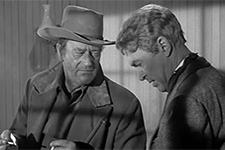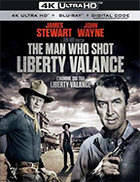The Man Who Shot Liberty Valance (4K UHD)
|  The tensions between wilderness and civilization, personal justice and the legal system, the individual and the community have always fueled the Western genre, but they have never been laid quite so bare as in John Ford’s The Man Who Shot Liberty Valance. The majority of the story is told in flashback by an aging Senator named Ransom Stoddard (James Stewart), who returns to the small, but bustling town of Shinbone to attend the funeral of a man named Tom Doniphon, who no one in town seems to know. At the urging of the local newspaper editor, Ranse begins to tell his story, which starts with his coming to Shinbone many years earlier when he was fresh out of law school, an idealistic young man heeding Horace Greeley’s admonition to “Go West, young man.” At that time, Shinbone was caught between honest, struggling farmers who wanted the territory turned into a state so they could enjoy benefits such as roads and railways, and cattle barons, who wanted to keep the range free from federal intervention so they could continue to impose their own rule. The stagecoach Ranse on which comes into town is robbed at gunpoint by a sadistic local bully with the ironic name of Liberty Valance (Lee Marvin).Once Ranse gets to town, he quickly learns that everyone lives in petrified fear of Liberty, no one more so than the town marshal, a cowardly, but lovably rotund buffoon named Link Appleyard (Andy Devine). Ranse finds that his attempts to set up a law practice are futile, as no one in Shinbone seems to be interested in the federal legal system. He ends up washing dishes at the local tavern, where he meets a young woman named Hallie (Vera Miles). Here is also where he becomes acquainted with Tom Doniphon (John Wayne), who saved his life the night his stagecoach was robbed. Doniphon, who has his eye on Hallie for a future wife, is the only man in the territory who could possibly stand up to Liberty Valance. Much of the film is devoted to the increasing tension between Ranse’s idealistic desire to bring Liberty to justice (that is, have him arrested and tried in a court of law) and his dawning realization that, in this part of the world at this particular time, the only way for Liberty to get what he deserves is in the realm of personal justice, where the fast-drawn six-shooter replaces law books and legal practice. The Man Who Shot Liberty Valance is interesting in this respect, as it is an early example of the genre one might call “Re-Educating the Liberal,” in which nonviolent, often educated and socially progressive characters are shown the error of their ways in an ultraconservative narrative that forces them to realign with reactionary violence in order to survive. Both the original Cape Fear (1962) and Martin Scorsese’s 1991 remake fit this subgenre, as do early ’70s vigilante films like Walking Tall (1973) and Death Wish (1974). The screenplay by James Warner Bellah, a pulp novelist-turned-screenwriter whose short stories had served as source material for several of Ford’s previous films, including Fort Apache, She Wore a Yellow Ribbon, and Rio Grande, and Willis Goldbeck (the Dr. Kildare series) tries to balance this to some extend by portraying the killing of Liberty as both a triumph and a burden to bear for Ranse. And, as the story makes clear near the end, not everything is as clear-cut as it seems, which leads to the rightfully famous, but utterly cynical line, “When the legend becomes fact, print the legend.” When John Ford directed The Man Who Shot Liberty Valance (it was one of his last films), he had already won four Best Director Oscars and helmed so many Westerns that his name was virtually inseparable from the genre, despite his experience directingother types of films, including dramas and war films. He had also worked with John Wayne 11 times previously, including two of his most celebrated roles in Stagecoach (1939) and The Searchers (1956). One of Ford’s greatest strengths was his ability to bring out more in Wayne than other directors could; Ford gave him an edge and allowed him to flex some of the acting muscle he couldn’t elsewhere. As Tom Doniphon, Wayne is both hero and antihero; he stands up for what is “right,” but he also represents lawless violence in contrast to James Stewart’s upstanding idealism and belief in rule of law and order. Doniphon is cynical, yet also romantic, as is depicted in his fondness for Hallie. Yet, there is nothing sentimental about him, as he tends to be selfish and, at times, misogynistic, treating Hallie as if she were an object to be owned, rather than a woman to be loved. In many ways, Doniphon represents the tear within Ford himself between the conservatism that fueled his earlier films and the more liberated outlook that began to surface in some of his later work, most notably the complex racial dimensions of The Searchers. As Ranse, James Stewart proves to be somewhat problematic. His physical appearance immediately sets him as out of place in the untamed West, yet, at the age of 54, he was far too old to convincingly play a young man just out of school (the youthful James Stewart of Mr. Smith Goes to Washington [1939] would have been more appropriate). By the early 1960s, especially after working in the subversive world of Alfred Hitchcock (especially Vertigo), Stewart’s screen persona had become too complicated for him to revert back to his youthful idealism, and as a result his performance feels like he's reaching back to a long-gone past (plus he tends to overact the more emotional scenes). Yet, despite this weakness, The Man Who Shot Liberty Valance is still one of the crucial films of the Western genre. It is especially important for understanding John Ford as an auteur, as it is arguably the film that best distills the essence of his entire body of work. Beyond that, Liberty Valance foregrounds the tensions that fueled not only the Western genre, but also much of American literature. Yet, this in no way simplifies the film, as it remains a complex work that is both a nostalgic look back to a simpler time and a deepe xamination of the role of myths and legends in the painful struggle of a young nation as it moved from the wilderness into modernity.
Copyright © 2022 James Kendrick Thoughts? E-mail James Kendrick All images copyright © Paramount Home Entertainment | |||||||||||||||||||||||||||||
Overall Rating: 


 (3.5)
(3.5)


